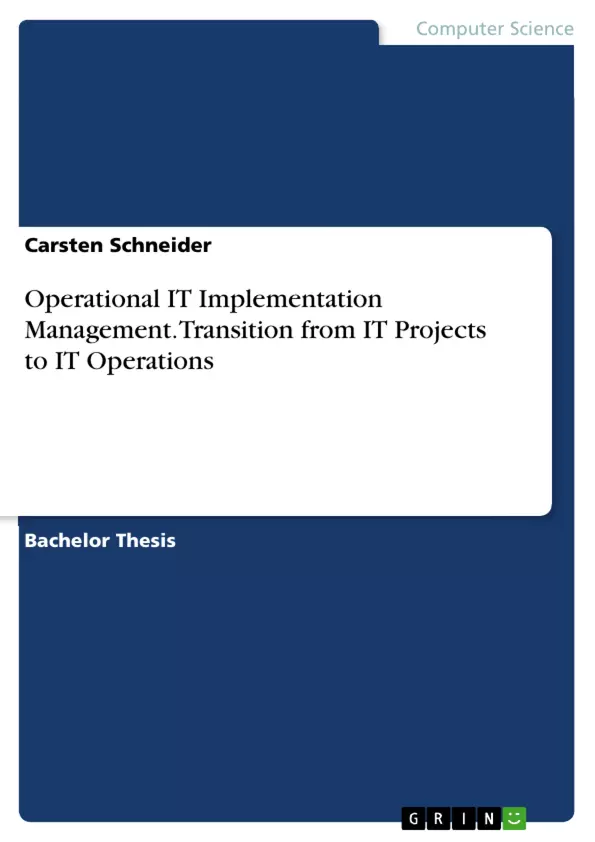
Operational IT Implementation Management. Transition from IT Projects to IT Operations
Bachelorarbeit, 2014
49 Seiten, Note: 1,5
Leseprobe
Inhaltsverzeichnis (Table of Contents)
- INTRODUCTION
- IT OPERATIONS
- DEFINITION OF IT OPERATIONS
- CORE PROCESSES FOR IT OPERATIONS
- CHALLENGES IN IT OPERATION
- IT PROJECTS
- PROJECT CHARACTERISTICS
- PROJECT MANAGEMENT AND PROJECT LIFE CYCLE
- PORTFOLIO AND PROGRAM MANAGEMENT
- CHARACTERISTIC OF IT PROJECTS
- INTERFACES BETWEEN IT OPERATIONS AND IT PROJECTS
- ORGANISATIONAL ASPECTS
- TRANSITION PROCESSES
- IT OPERATIONS ACTIVITIES DURING THE PROJECT LIFE CYCLE
- CONCLUSION AND FURTHER CONSIDERATIONS
Zielsetzung und Themenschwerpunkte (Objectives and Key Themes)
This thesis examines the complex relationship between IT projects and IT operations, focusing on the transition process from project implementation to ongoing operations within a company's IT landscape. The aim is to understand the challenges and best practices involved in ensuring a smooth and effective handover, ensuring continuous service delivery and maximizing the value of IT investments.
- Defining and comparing the characteristics of IT projects and IT operations.
- Analyzing the core processes and challenges inherent in IT operations.
- Exploring the key aspects of project management and the project lifecycle.
- Identifying the critical interfaces and transition processes between IT projects and IT operations.
- Investigating the role of IT operations in supporting the project lifecycle.
Zusammenfassung der Kapitel (Chapter Summaries)
- Introduction: This chapter introduces the central theme of the thesis - the transition from IT projects to IT operations. It highlights the challenges faced by IT departments in balancing the need for reliable and user-friendly services with the demand for adaptability in a rapidly changing business environment.
- IT Operations: This chapter delves into the fundamental aspects of IT operations, defining its core processes and outlining key challenges. It explores the need for a stable IT infrastructure while simultaneously ensuring flexibility to meet evolving business requirements.
- IT Projects: This chapter examines the characteristics of IT projects, their management frameworks, and their life cycle. It emphasizes the importance of project management methodologies like ITIL and PMI in achieving project success.
- Interfaces between IT Operations and IT Projects: This chapter analyzes the critical interfaces between IT projects and IT operations, focusing on organizational structures, transition processes, and the role of IT operations during the project lifecycle. It highlights the importance of effective communication and collaboration to ensure a smooth handover of project outcomes.
Schlüsselwörter (Keywords)
This thesis focuses on the critical connection between IT projects and IT operations, using keywords such as IT project, IT operation, transition, ITIL, PMI, IT service lifecycle, project lifecycle, flexibility, stability, and frameworks.
Details
- Titel
- Operational IT Implementation Management. Transition from IT Projects to IT Operations
- Hochschule
- BA Hessische Berufsakademie
- Note
- 1,5
- Autor
- Carsten Schneider (Autor:in)
- Erscheinungsjahr
- 2014
- Seiten
- 49
- Katalognummer
- V296318
- ISBN (eBook)
- 9783656943242
- ISBN (Buch)
- 9783656943259
- Dateigröße
- 985 KB
- Sprache
- Englisch
- Schlagworte
- IT projects IT operation transition IT projects vs. IT operation handover ITIL PMI IT service lifecycle project lifecycle flexibility vs. stability frameworks IT organisation IT Betrieb IT Projekte Betriebsübernahme
- Produktsicherheit
- GRIN Publishing GmbH
- Preis (Ebook)
- US$ 19,99
- Preis (Book)
- US$ 29,99
- Arbeit zitieren
- Carsten Schneider (Autor:in), 2014, Operational IT Implementation Management. Transition from IT Projects to IT Operations, München, Page::Imprint:: GRINVerlagOHG, https://www.diplomarbeiten24.de/document/296318
- Autor werden
- Ihre Optionen
- Vertriebskanäle
- Premium Services
- Autorenprofil
- Textarten und Formate
- Services für Verlage, Hochschulen, Unternehmen

- © GRIN Publishing GmbH.
- Alle Inhalte urheberrechtlich geschützt. Kopieren und verbreiten untersagt.
- info@grin.com
- AGB
- Open Publishing
Der GRIN Verlag hat sich seit 1998 auf die Veröffentlichung akademischer eBooks und Bücher spezialisiert. Der GRIN Verlag steht damit als erstes Unternehmen für User Generated Quality Content. Die Verlagsseiten GRIN.com, Hausarbeiten.de und Diplomarbeiten24 bieten für Hochschullehrer, Absolventen und Studenten die ideale Plattform, wissenschaftliche Texte wie Hausarbeiten, Referate, Bachelorarbeiten, Masterarbeiten, Diplomarbeiten, Dissertationen und wissenschaftliche Aufsätze einem breiten Publikum zu präsentieren.
Kostenfreie Veröffentlichung: Hausarbeit, Bachelorarbeit, Diplomarbeit, Dissertation, Masterarbeit, Interpretation oder Referat jetzt veröffentlichen!
- GRIN Verlag GmbH
-
- Nymphenburger Str. 86
- 80636
- Munich, Deutschland
- +49 89-550559-0
- +49 89-550559-10
- info@grin.com
-









